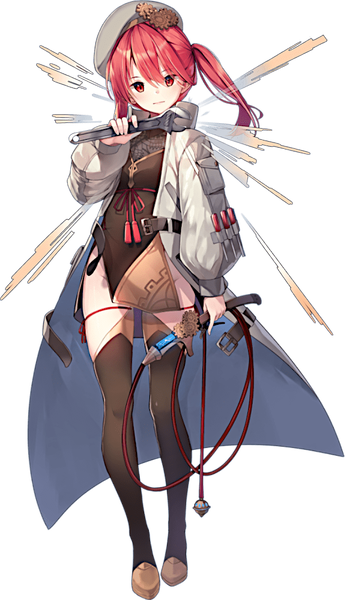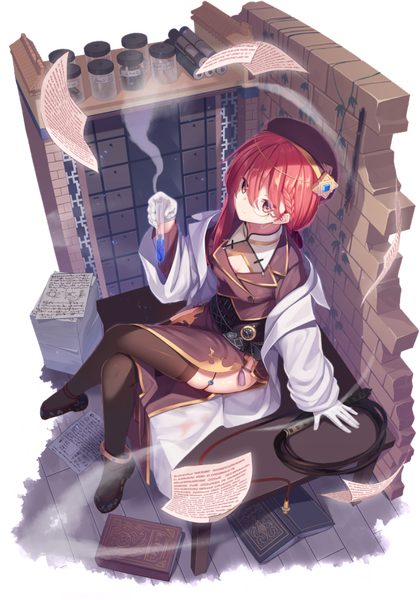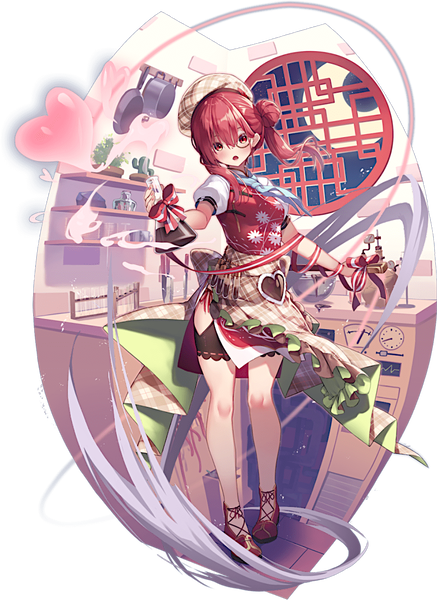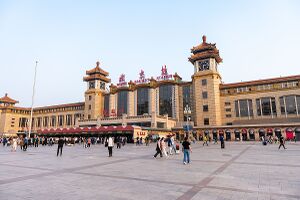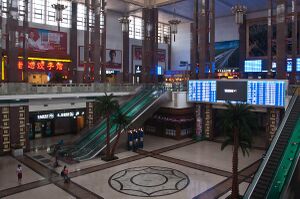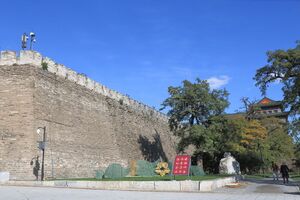Beijing
| Beijing | |||||
|---|---|---|---|---|---|
| Japanese Name | ペイジン | ||||
| Weapon | |||||
| Race | Human | ||||
| Nationality | |||||
| Birthday | September 15 | ||||
| Constellation | Virgo | ||||
| Talents | Able to combine and control machines and mist stones | ||||
| Likes | All types of dim sum, Manhua | ||||
| Dislikes | All sweet things | ||||
| Strengths | Doesn't discriminate or have any notion of prejudice | ||||
| Weaknesses | Cannot be honest with what she thinks | ||||
| Hobbies | Inventing things unrelated to her work | ||||
I'm Beijing and I'm part of the Eisengrad Central Army. Probably better to call myself a researcher instead of a soldier, you see. I'm doing research in combining the magic of mist stones with various things. Not just weapons, but everyday objects and even toys for kids! If you've a good idea, let me know. I'll be sure to try it out.
Layers
| Icon | Title | Release Date | Where to Obtain |
|---|---|---|---|
| [Genius Inventor] Beijing | 2021 August 30 (EN) | Premium Gacha | |
| [Modest Humanist] Beijing | 2021 October 15 | [Warm Welcome! Battle Girl's Extreme Cram School!] Pick Up Gacha, Premium Gacha | |
| [Research Today is Definitive As Well] Beijing | 2024 May 16 | [Let It Be a Vivid Fashion Revolution] Pick Up Gacha, Premium Gacha | |
| [Kind Scholar] Beijing | 2021 August 30 (EN) | Premium Gacha | |
| [Engineer Who Acts First] Beijing | 2022 March 16 (EN) | 0.5 Anniversary Limited Gacha 1 | |
| [Valet and Valentine] Beijing | 2023 January 31 | [The Sickness Unto Chocolate] Limited Gacha | |
| [Maiden's Clandestine Training] Beijing | 2023 September 22 | 3rd Anniversary Limited Gacha 2 |
Owned Skills
Trivia
- Beijing's birthday is the opening date of Beijing railway station (completed on September 10) in 1959.
- Beijing's assistant researcher and bodyguard is Tianjin, who graduated as a Train Knight in the story of [Kind Scholar] before Tianjin got her playable debut.
- Shanghai is Beijing's close friend and primary investor for her research.
- Beijing's favourite food, dim sum (点心/點心; pinyin: diǎnxīn) is a large range of small Chinese dishes that are traditionally enjoyed in restaurants for brunch. Most modern dim sum dishes originated in China and are commonly associated with Cantonese cuisine, although dim sum dishes also exist in other Chinese cuisines.
- Manhua (漫画/漫畫; pinyin: mànhuà) are Chinese-language comics produced in China and Taiwan. The word manhua was originally an 18th-century term used in Chinese literati painting. It became popular in Japan as manga in the late 19th century. Feng Zikai reintroduced the word to Chinese, in the modern sense, with his 1925 series of political cartoons entitled Zikai Manhua in the Wenxue Zhoubao (Literature Weekly).
- The street lamp in the background of [Engineer Who Acts First] is the street lamps located in the entrance of Beijing Railway Station.
- The "laboratory rack" wall in the background of both [Kind Scholar] and [Engineer Who Acts First] is a section of the real life Beijing city fortifications. The walls are mostly destroyed, but parts of the wall is preserved in the park located south of Beijing railway station.
Counterpart
Beijing railway station (北京火车站/北京火車站; pinyin: Běijīng Huǒchēzhàn), or simply Beijing station (北京站; pinyin: Běijīngzhàn), is a passenger railway station in Dongcheng District, Beijing. The station is located just southeast of the city center inside the Second Ring Road with Beijing Station Street to the north and the remnants of the city wall between Chongwenmen and Dongbianmen to the south. The Beijing railway station opened in 1959 and was the largest train station in China at the time. Though superseded by the larger Beijing West and Beijing South stations, this station remains the only one located inside the old walled city. Trains entering and leaving the station pass by the Dongbianmen corner tower. With gilded eaves and soaring clock towers, the architecture of the railway blends traditional Chinese and socialist realist influence.
The Beijing railway station's predecessor was the Zhengyangmen railway station, also called the Beijing station, which was located 2.5 km (1.6 mi) due west, just outside Zhengyangmen (also known as Qianmen), a gate in the city wall directly south of Tiananmen Square. The Zhengyangmen railway station was built in 1901 and served as the terminus of the Kaiping Tramway and Imperial Railways of North China, also known as the Beijing–Shanhaiguan Railway until 1959 when the station closed after the opening of the current Beijing railway station and has become part of the China Railway Museum.
Construction of Beijing railway station started on January 20, 1959. More than 20000 construction personnel was involved in the project, and the project investment was 57.82 million yuan, where Soviet experts also gave on-site technical guidance. Construction was completed on September 10, 1959, just over seven months later. The new Beijing Railway Station covers a total area of 250000 square meters. The Beijing railway station was one of the largest construction projects in mainland China during that time with modern facilities and it was also China's first large modern railway terminal. At the time of completion, the station has a twelve tracks and six railway platforms with canopies attached to them.
The Station house building faced south and the architecture included both a Chinese traditional style and the Soviet Stalinist architecture. The twelve passenger waiting rooms comprised a total area of fourteen thousand square meters and was able to accommodate 14000 waiting passengers. The inner complex of the Main Station Building contained a passenger waiting room, mother and child waiting room, movie theater, recreation hall, visitors' restaurants, post office, clinic and other facilities. Installed on the roof of the Station House were two marble clock faces and every morning from 7am to 9pm the bell sounded punctually and "The East Is Red" song is played out.
In June 2008, in order to meet the needs of the Beijing Olympic Games, bilingual signs were created at the Beijing railway station to facilitate an overall increase in foreign tourists travelling to the games, in addition to putting up the English name "Beijing Railway Station", several other signs were also erected at station entrances, exits and ticket booths. Wikipedia
The Beijing city fortifications were walls with series of towers and gates constructed in the city of Beijing, China in the early 1400s until they were partially demolished in 1965 for the construction of the 2nd Ring Road and Line 2 of the Beijing Subway. The original walls were preserved in the southeastern part of the city, just south of the Beijing railway station. The entire perimeter of the Inner and Outer city walls stretched for approximately 60 kilometres (37 mi).
Beijing was the capital of China for the majority of the Yuan, Ming, and Qing Dynasties, as well as a secondary capital to the Liao and Jin Dynasties. As such, the city required an extensive fortification system around the Forbidden City, the Imperial City, the Inner city, and the Outer city. Fortifications included gate towers, gates, archways, watchtowers, barbicans, barbican towers, barbican gates, barbican archways, sluice gates, sluice gate towers, enemy sighting towers, corner guard towers, and a moat system. It had the most extensive defense system in Imperial China. After the collapse of the Qing Dynasty in 1911, Beijing's fortifications were gradually dismantled. The Forbidden City has remained largely intact, becoming the Palace Museum. Some fortifications remain intact, including Tiananmen, the gate tower and watchtower at Zhengyangmen, the watchtower at Deshengmen, the southeastern corner guard tower, and a section of the Inner city wall near Chongwenmen. The latter two components now form the Ming City Wall Relics Park. None of the Outer city remains intact. Yongdingmen was completely reconstructed in 2004. Wikipedia
Map
Gallery
- Pages using Tabber parser tag
- Pages using DynamicPageList3 parser tag
- Weapon Whip
- Human
- Eisengrad
- Virgo
- Element Blow
- Element Water
- Element Fire
- Element Light
- Element Wind
- Train Knights
- China



